Algae for Tilapia
Contents
Feeding

Tilapia start feeding shortly before dawn and feed continually (but most intensively between 12:00 and 18:00[4]) until about dusk. They do not feed during the night.[5][6] Tilapia (Oreochromis niloticus) may effectively control algal blooms in eutrophic waters.[7] Planktonic plants and -animals make up the bulk of the diet under natural conditions.[8] Zooplankton (animal) does not exceed 1.5% of total stomach contents [9], with predation pressure being the greatest on Ceriodaphnia reticulata (small water fleas that feed on small algae).[10] Phytoplankton (plant plankton) may contribute over 30% by volume of stomach contents of Oreochromis niloticus.[11] Small Tilapia rendalli consumed more diatoms than larger individuals.[12] Oreochromis niloticus feeds mainly on zooplankton until 5 cm long, and mainly on phytoplankton as it grows older. In small fish (<75 g.) Bacillariophyceae are the main phytoplankter, and in larger fish Chlorophyceae are.[13] Tilapia (Sarotherodon melanotheron) shift from visually feeding on zooplankton when juveniles to mostly filter feeding on phytoplankton when adults [14], consuming less Microcystis and Scenedesmus as they grow bigger.[15] Blue-green algae are common components of the Tilapia diet. In the stomach of Tilapia nilotica the cells of blue-green algae are lysed by high concentrations of acid (pH 1.4–1.9). After lysis, cell contents are digested in the intestine (by pepsinogen, a pancreatic α-amylase, trypsin, chymotrypsin and esterase activity). Acid is secreted in relation to feeding. Acid is not secreted by stressed fish.[16] Filtration rates of algae increases linearly as water temperature increases from 17°C to 32°C.[17]
Algal growth
The favourable pH range for plankton growth ranges between 6.5 and 7.5. Acidic conditions favor chlorophytes (green algae) while alkaline condition fosters nitrogen-fixing cyanobacteria.[18] In phytoplankton-based recirculating systems, algae may rather be limited by dissolved organic carbon availability rather than by nitrogen or phosphorus.[19] Chlorella vulgaris has higher lipid contents than Scenedesmus abundans and Monoraphidium minitum, which was also reflected in their predator, Brachionus calyciflorus. [20] Most fertilized fish ponds with dirty green water have more than 242 mg phytoplankton biomass per L water.[21]
Selective feeding


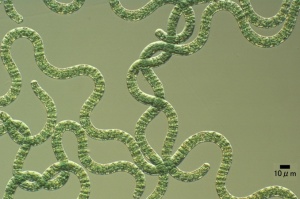
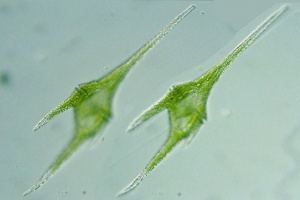
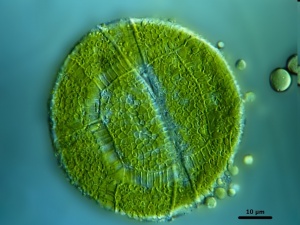
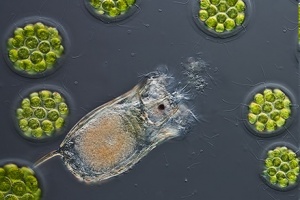
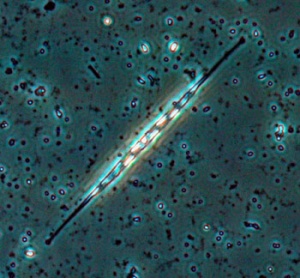
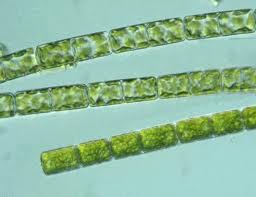
Tilapia feed selectively on large algae, mainly cyanobacteria and diatoms.[22] Oreochromis niloticus may select only Cyanophyta and Euglenophyta, with occasional Bacillariophyta.[23] Oreochromis niloticus may select Cyanophyta and sometimes select Bacillariophyta and Euglenophyta.[24] Blue tilapias (4.3 to 18.7 cm long) selectively feed on particles larger than 25 μm.[25] Nile tilapia is particularly effective in filtering the larger particle size taxa.[26] Larger phytoplankton (plant plankton) are being filtered proportionally more than the smaller phytoplankton, and cyanobacteria (in 100% of fish[27]) more than green algae (Scenedesmus, Ankistrodesmus, Tetraedron).[28] Tilapia aurea (Blue tilapia) favour Uroglenopsis sp. (cells forming hollow spherical colonies, > 400 μm diameter), Ceratium sp.(dinoflagellate, 310 μm long, 58 μm wide; optmum salinity 10 ppt[29]) and Keratella sp. (100 μm long 'wheel animals') over (small-sized algae) Rhodomonas sp., Chrysochromulina sp., Chlamydomonas sp., Cyclotella sp. and (zooplankter) Diaptomus sp.[30] Oreochromis niloticus may prefer Spirulina laxisma and Nitzschia accicularis the most. The least preferred food items may be Lyngbya circumcreta, Microcystis aeruginosa and Pediastrum simplex.[31]
The main species of algae found in Oreochromis niloticus stomach belonged to Cyanophyta, Chlorophyta, Bacillariophyta and Euglenophyta.[32] The most frequent species represented in Oreochromis niloticus stomach are Anabaena sp., Merismopedia eleganse, Microcystis aeruginose, Nodularia harveyana and Oscillatoria sp. (Cyanophyta), Cerasterias sp., Chlorella spp., Crucigenia sp., Pediastrum spp., Scenedesmus spp. and Tetraedron sp. (Chlorophyta), Amphora ovalis, Cocconeis placentula, Cymatopleura solea, Cymbella cistula, Gyrosigma attenuatum, Melosira granulata, Navicula spp., Nitzschia spp., Pinnularia spp., Serurella sp. and Synedra sp. (Bacillariophyta) and Euglena and Phacus spp. (Euglenophyta).[33] The most frequent genera represented in fish (Oreochromis niloticus) stomach in all sizes were Anabaena, Anabaenopsis, Coleospharium, Merismopedia, Microcystis, Nodularia, Oscillatoria, Spirulina (Cyanobacteria), Actinostrum, Chlorella, Closterium, Coelastrum, Eudrina, Pandorina, Pediastrum, Scenedesmus, Shereoderia, Staurastrum (Chlorophyceae), Amphora, Cocconeis, Cymatopleura, Cymbella, Gyrosigma, Melosira, Navicula, Pinnularia, Synedra (Bacillariophyceae) and Euglena and Phacus (Euglenophyceae).[34] Botryococcus sp. (green algae)[35][36] and Melosira (a diatom; Bacillariophyceae)[37] may also be major food items in the diet of Oreochromis niloticus.
Peridinium cinctum
Peridinium species are large phytoplankton that less efficiently take up nutrients than smaller species. At their advantage is the capacity to modify their position in the water column (in accordance with light and nutrient availability), that they are (because of their large size) inedible by most zooplankton, and their extremely low phosphorus requirements (C:P molar ratio is 460:1).[38] They may produce 2 to 3 times more organic matter than other alga.[39]
Tilapia (galilaea) favourably consume Peridinium cinctum (30-70 μm armoured dinoflagellates).[40] Feeding rates of Tilapia galilaea and Tilapia aurea reach maximum values for zooplankton (animal plankton) and Peridinium cinctum.[41] Fingerlings fed experimentally on chlorophytes had lower growth rates compared with mosquito larvae, zooplankton and fresh Peridinium.[42] Growth rates of age-1 Tilapia galilaea on Peridinium may be 1–2% mean weight per day.[43]
When phosphorus is low, Peridinium has an advantage over other alga.[44] Peridinium aciculiferum may particularly produce toxins when deprived of phosphorus and in stationary phase.[45] Blooms of Peridinium gatunense (biomass > 100 g / m2) may change the color of the water to coffee brown in distinct patches and are associated with excessive oxygen super-saturation, and high phosphorus (> 0.05 mg/L) and nitrogen (> 1 mg/L).[46] Peridinium gatunense and Microcystis sp. are highly competitive.[47] Peridinium ponticum may thrive in 17 ppt salinity.[48] Peridinium cinctum is common below 20 ppt salinity.[49]
Nitzschia
Nitzschia accicularis is a diatom (100 to 500 µm long), belonging to the Bacillariophyta (phytoplankton). Oreochromis niloticus may prefer Spirulina and Nitzschia accicularis the most.[50] Nitzschia accicularis may tolerate high salinity.[51] Optimum photosynthetic activity by Nitzschia closterium is at 10 ppt [52], but it may tolerate salinity over 35‰ (ppt).[53] Optimum salinity for Nitzschia americana growth is 26 ppt.[54] Nitzschia ovalis may grow at salinities from 5–40‰ (ppt).[55] Pseudo-Nitzschia may tolerate up to 45 ppt salinity.[56]
Anabaena
Anabaena sp. are large filamentous and neurotoxin-producing cyanobacteria (blue-green algae) that exist as plankton. Feeding mostly on Anabaena spiroides, Oreochromis niloticus (mean total weight: 31.5 g) may ingest 5.1% body mass equivalent (wet weight basis).[57] Ingestion rates are higher on Anabaena cylindrica than on Microcystis aeruginosa.[58] Anabaena flos-aquae is much better assimilated (83%) than green algae. Gross growth efficiency of fish fed Anabaena flos-aquae was 46% in comparison to fish fed Chlamydomonas (22%) and Ankistrodesmus falcatus; 24%.[59] Tilapia grow much better on Anabaena than on Clamydomonas (green algae) [60] Nile Tilapia fed ration equal 3% of the total fish body weight, containing 1.5% Anabeana had higher growth and were relatively protected against A. hyrophila infection.[61] Anabaena circinalis may cause off-flavor in fish flesh.[62] In competition experiments between Anabaeana and toxic Microcystis aeruginosa, dominancy is mainly determined by the initial biomass ratio.[63] Anabaena circinalis and Anabaena spiroides thrive in salinity less than 3 ppt.[64] Anabaena tortulosa is relatively tolerant of salinity up to 15 ppt.[65] Salt tolerance in cyanobacteria is increased by nitrogenous compounds (inhibiting Na+ influx), but by nitrate more so than by ammonium or glutamine.[66]
Spirulina
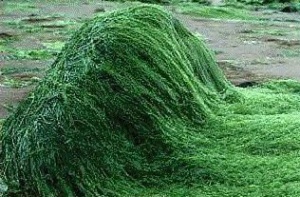

Spirulina (Arthrospira) are blue-green algae/cyanobacteria and a rich source of protein and potassium.[67] Spirulina platensis contains 50 to 65% protein (10% is non-protein nitrogen)[68], is high in vitamin B1 and B6 and is 85 to 95% assimilated. It may contain up to 14% lipids (of dry mass). [69] Spirulina platensis growth is optimum below 10.5 pH.[70] Spirulina platensis is naturally found in tropical regions inhabiting alkaline lakes (pH 9.4 to 11 ; HCO3 + CO2 > 51 meq/L [71]) with high concentration of NaCl and bicarbonates [72], but may adapt to very different habitats, including freshwater.[73] At higher salt levels (2.5 to 30 g. salt / L), Spirulina becomes more dominant (with Anabaenopsis, Oscillatoria, Synechocystis), or even the only significant organism (> 30 g. salt / L)[74] Oreochromis niloticus may fairly tolerate salinity up to 10 ppt [75] Tilapia may tolerate 0.5% salinity (5 ppt).[76] At 8 g / L salinity adult Oreochromis niloticus may be stocked at 40 fish / m3. At 15 g/L salinity total production is more than halfed.[77]
Spirulina platensis (small biomass) may be grown on human urine.[78] At pH 8.4, urea may be used as a source of nitrogen up to 1.5 g./L [79], the best growth temperature being 29°C [80] at an appropriate slowly increasing urea feeding rate.[81] Regarding phosphorus, maximum biomass production at high light intensity was observed at 250 mg/L K2HPO4.[82] The optimum nitrogen:phosphorus ratio is 7:1 at optimum light intensity.[83] The temperature range for optimum Spirulina growth is 30 to 35°C.[84] At 35°C there is a negative effect on biomass production but a positive effect on the production of protein, lipids and phenolics.[85] Spirulina may be cultivated in water with 16 g/L baking soda, 2 g/L Potassium nitrate, 1 g/L sea salt, 0.1 g/L potassium phosphate and 0.01 g/L iron sulphate. [86] In an open raceway system dissolved oxygen may reach 30 mg/L at 28°C. Above 25 mg/L Spirulina growth is inhibited.[87]
Larval tilapia that were fed solely raw Spirulina at a feeding rate of 30% (on a dry basis) of bodyweight in the first 3 weeks, 10% in weeks 4–6, and 3% in weeks 7–10, kept growing without any abnormality[88], at a slightly lower rate than fish fed fishmeal. Fish fed Spirulina had higher protein, polar lipid, linoleic acid and γ-linolenic acid contents and lower ash and omega-3 contents than fish fed the commercial diet.[89] Elastic modulus of flesh of the Spirulina-fed fish was significantly higher and viscosity lower.[90] Larval Tilapia (Oreochromis niloticus < 3.4 cm) prefer consuming Spirulina platensis over Euglena gracilis (flagellate protists), and is also more readily assimilated. Tilapia prefer both species over Chlorella vulgaris (green algae, 45% dry matter protein), which is hardly ingested by larval tilapia.[91] Tilapia prefer Spirulina over Navicula (a diatom).[92] In Tilapia aurea fed Spirulina platensis, food conversion was 2.0.[93] Dietary Spirulina incorporation increases antioxidant activity in tilapia.[94] During a period of nitrogen starvation, Spirulina platensis may survive and grow unaffected based on/due to prior storage of nitrogen in pigment proteins (C-Phycocyanin).[95]
Microcystis
Microcystis sp. may account for more than 80% of ingested phytoplankton.[96] Various cyanobacteria may produce toxins (eg Microcystis aeruginosa). Average digestion rate of Microcystis aeruginosa (cyanobacteria producing neurotoxins and hepatotoxins) by Tilapia fingerlings is 58 to 78% at 25℃.[97] Oreochromis mossambicus exposed to extracts from Microcystis aeruginosa showed significant plasma hypocalcaemia.[98] Toxin producing cyanobacteria do not (negatively) affect growth, feed conversion efficiency, health or mortality in Oreochromis niloticus. Microcystins do accumulate in muscle tissue (and particularly in the liver), which may exceed the upper limit of the tolerable daily intake of microcystins suggested by the WHO (0.04 μg/kg body weight/d).[99] Accumulation of microcystis increases lipoxidation (a biomarker of oxygen-mediated toxicity) in the liver.[100] Microcystin concentrations in the liver and intestine may gradually decrease as a result of the capacity in Tilapia to depurate and excrete mycrocystins into the bile and surrounding water, to avoid toxicity.[101] During the depuration period, muscle tissue may contain the highest concentration of microcystins, which may exceed the tolerable limit for humans (even in combined diets).[102] Microcystis wesenbergii is non-toxic, less competetive, but more suited to low phosphorus environments than Microcystis aeruginosa.[103] Microcystis flos-aquae is more dominant in salinity above 3 ppt, whereas Microcystis_aeruginosa is dominant in salinity up to 3 ppt.[104]
Periphyton
Periphyton is a mixture of algae, cyanobacteria, heterotrophic microbes and detritus (mainly scraps of macrophytes and mud [105]) attached to submerged surfaces embedded in a slimy mucopolysaccharide matrix.[106] Surface-grazing on periphyton is greater than on Microcystis aeruginosa. For tilapia, filter-feeding may be a relatively unimportant method of ingesting algae.[107] Tilapia mossambica feeds almost exclusively on periphytic detrital aggregate. (Assimilation efficiencies: organic matter 63%, protein 77%, carbohydrate 63%) [108] Feed conversion ratio of dry matter periphyton may be 2.81. Fish growth may be sustained on periphyton despite 55% (dry matter) ash content.[109] The fresh microbial mat was 81% digestible by Nile tilapia, comparing favorably with commercial catfish feed in digestibility by Nile tilapia. The dried form was significantly less digestible.[110] Tilpia are equiped with a 'stomach bypass' to be able to bypass or regurgitate unwanted materials.[111]
Algae meal
Under most unnatural feeding conditions tilapia are unable to sufficiently ingest high volumes of algae. They may need constant grazing to fulfill their nutrient requirements.[112] Tilapia (Sarotherodon niloticus) grow better on fishmeal (fish meal may contain 74% protein and 8% lipids.[113]) than on a 25% protein green algae meal (Cladophora glomerata). Weight gain decreased as the level of algal protein increased as replacement of fish meal. Protein digestibility was highest on a 5:1 ratio (fishmeal : green algae meal).[114] Protein synthesis (with normal sulfur and carbon content) by green algae during the night may match protein synthesis during the day (in Dunaliella tertiolecta).[115] Protein derived from algae does not promote adequate growth in Rainbow trout.[116] Fish fed 5% ulva meal (Green algae; Ulva rigida) showed increased growth, feed conversion ratio and protein efficiency ratio.[117] Ulva meal may replace soy bean meal to the extend of 20% without negatively affecting growth of male larval tilapia. Feed conversion ratio increased with increasing ulva meal content.[118] Green algae meal (Hydrodictyon reticulatum) may replace meal to the extend of 25% without negatively affecting growth of Oreochromis niloticus and Tilapia zillii fingerlings.[119] Spirulina maxima meal protein can replace up to 40% of the fish meal protein in Oreochromis mossambicus fry diets without negatively affecting growth.[120]
Off-flavor
Cyanobacteria causing off-flavor (by geosmin and 2-methylisoborneol, MIB in fish flesh) are Oscillatoria tenuis, Anabaena circinalis and Pseudanabaena catenata. Tilapia flesh derived from cage culture provided a lower possibility of off-flavor contamination than those from earthen ponds.[121]